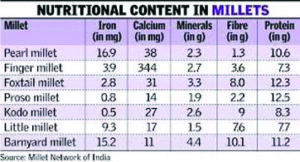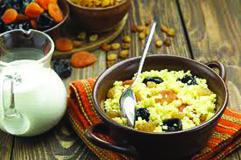NE NEWS SERVICE
NEW DELHI, DEC 22
In a first ever scientific study of its kind in schools, millet based mid-day meals were found to significantly boost child growth in terms of body mass index (BMI), nutrition and also can be a better rice substitute in India.
Findings of the study published in the journal Nutrients were released on Wednesday by NITI Aayog member Ramesh Chand, and CEO of the National Rainfed Area Authority, Ashok Dalwai. Both of them spoke about nutritional value of millets and also on how it could promote sustainability.

The study — ‘Acceptance and impact of millet based mid-day meal on nutritional status of adolescent school going children in a peri-urban region of Karnataka state in India’ — may help in creating awareness among consumers and farmers for opting millets which were last year notified by the central government as ‘nutri-cereals’. The Centre has also allowed inclusion of millets in the Public Distribution System (PDS) for improving nutritional support.
The millet-meals study was conducted by NGOs — International Crops Research Institute for the Semi-Arid Tropics (ICRISAT) and the Akshaya Patra Foundation — in government schools in four villages around Bengaluru.
During the study period of three months, millet-based mid-day meals were fed to 1,500 adolescent children at two schools, of which 136 were studied as an intervention group and were compared with 107 other children in two other schools that did not receive the intervention. The growth assessment of children includes height, weight and age.
The study in its conclusion said that the introduction of millet-based meals in school feeding programmes can significantly improve the nutritional outcome of children compared to fortified rice-based meals. It noted that “the nutritional benefits were positive in just a three-month period when other factors such as the health status of the children was normal”.
The report comes at a time when the Centre has been trying to promote millets – both for its nutritional value and climate-resilient properties. The millets include Sorghum (Jowar), Pearl Millet (Bajra), Finger Millet (Ragi), Foxtail Millet (Kangani/Kakun) and Buckwheat (Kuttu) and these can be grown with little use of water.
The central government had last year even substantially increased the minimum support price (MSP) of millets so that farmers may opt for it as alternative to water guzzling crops such as paddy and sugarcane. Procurement of millets has, however, not yet picked up.
“Millets are indeed superior cereals in terms of nutrition and also in terms of sustainability. They are ideally suited to address child undernutrition and fits very well in nature friendly production. Use of millets in various nutrition intervention programmes and in PDS will be of great help to address malnutrition and improve health,” said Chand.
Though over 500 million people in more than 30 countries depend on sorghum as a staple food, these grains have largely been abandoned in favour of more popular crops like maize, wheat, rice and soybeans in the past 50 years.
Acting on India’s proposal, the Food and Agriculture Organisation (FAO) of the United Nations has already agreed to celebrate ‘International Year of Millets’ in 2023.
The report comes at a time when the Centre has been trying to promote millets, both for its nutritional value and climate-resilient properties









